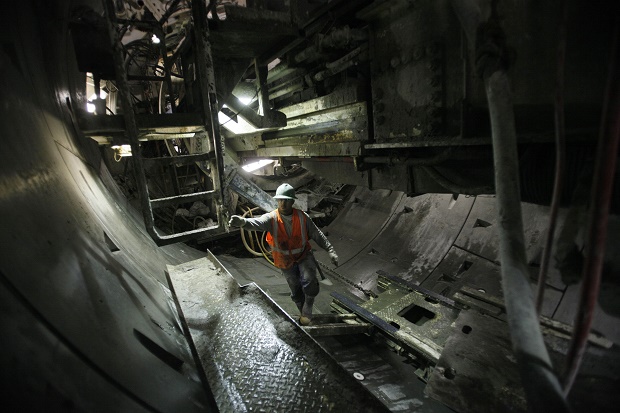Future of New York City mass transit hinges on funding fight

In this Feb. 3, 2010, file photo, a sand hog works inside the tunnel-boring machine that carves out the massive cavern for the new 34th Street Station in New York. When it opens on Sunday, Sept. 13, 2015, the subway station on Manhattan’s far west side extends the No. 7 train 1 1/2 miles past its current last stop in Times Square, and it’s the first station added to the system since 1989. AP FILE PHOTO
NEW YORK — The New York subway system was a gleaming symbol of American ingenuity when it opened in 1904. Now it rattles along past aging stops, controlled by cloth-insulated electrical wiring and signal devices almost as old as the tunnels themselves.
The Metropolitan Transportation Authority has a $29 billion modernization plan that would add high-tech control systems, replace old subway cars and buses, and expand service on North America’s largest transit system. But a dispute over who should pay for the work threatens to undermine it.
New York Gov. Andrew Cuomo and New York City Mayor Bill de Blasio are at odds over how to cover a spending gap in the MTA’s five-year capital plan. Cuomo has promised $8.3 billion in additional state dollars and wants the city to pay $3.2 billion.
“I’m putting my money where my mouth is — $8 billion,” Cuomo said on public radio this week. “The city has to do its fair share. I can’t say to Buffalo, ‘You should fund the New York City subway.'”
The city raised its offer to $2.5 billion on Thursday, according to a person familiar with the talks but not authorized to speak about the negotiations. In exchange, de Blasio wants the city to get a say in how the funds are spent and assurances that funding won’t be redirected to other purposes. The city’s initial offer was $657 million.
De Blasio notes that nearly 75 percent of MTA revenue comes from city residents in the form of fares, tolls and taxes. The city also complains that Westchester, Nassau and other surrounding counties benefit from the MTA but don’t make individual contributions.
“The people of New York City are already shouldering a huge burden when it comes to the MTA,” the mayor said Thursday. “I’ve said we are open to considering other contributions, but there have to be some very clear ground rules. We have to be certain that the state’s contribution is real and definable and verifiable.”
The back and forth is the latest skirmish in a longstanding feud between the two leaders. Cuomo laughed off de Blasio’s concerns about the state’s funding promises as “a joke” and has suggested the mayor call former Mayor Michael Bloomberg, whom Cuomo praised for making significant investments in the MTA.
During a period when Bloomberg was mayor, the city contributed 11 percent of the capital program. But mayoral aides argue that number is inflated by the construction needed to extend the 7 train line, which was funded by city dollars. They also point out that the average annual contribution since 1982 is just under 7 percent.
If the plan doesn’t get funded, riders will have to put up with continued delays, aging subway cars and buses and outdated control systems while the MTA continues to fall behind more modern transit systems in global cities such as London, Paris and Hong Kong.
“The system is deteriorating and the deterioration will only accelerate,” said Richard Ravitch, a former New York lieutenant governor who led the MTA from 1979-1983. “There’s a lot that needs to be done: modernization, expansion, a total revamping of the signal system. It’s a sad commentary.”
The MTA’s plan calls for new control systems on Metro North and Long Island Rail Road designed to prevent collisions; more real-time countdown clocks at subway stations; new buses, subway and train cars; 86 miles of replacement subway track, continued work on the 2nd Avenue Subway plan, secondary rail lines on Long Island; and $3 billion for bridges and tunnels.
Authority officials hope a funding agreement is in place before they meet Oct. 28, and outside groups are calling for a resolution. Labor unions that stand to pick up construction work under the project have called on the city to increase its investment. More than two dozen state lawmakers wrote to Cuomo earlier this week urging a swift resolution.
“There is always all this sound and fury around negotiations,” said Gene Russianoff of the Straphangers Campaign, a group that advocates for riders. “There is too much at stake to walk away. If this doesn’t happen there will be billions less for new subway cars and making sure stations aren’t filled with rats and peeling paint.
“Every indication is that they’re very close on most of the issues. There’s nothing they shouldn’t be able to resolve.”
RELATED STORIES
To solve Manila’s traffic woes — a subway system, anyone?
Berlin subway map printed in Arabic, with refugee’s help